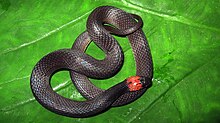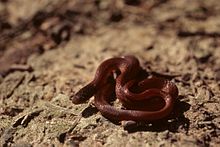Dipsadinae
| Dipsadinae | ||||||||||||
|---|---|---|---|---|---|---|---|---|---|---|---|---|

|
||||||||||||
| Systematics | ||||||||||||
|
||||||||||||
| Scientific name | ||||||||||||
| Dipsadinae | ||||||||||||
| Bonaparte , 1838 |
The xenodontinae are occurring in North, Central and South America subfamily smaller snakes from the family of snakes (Colubridae).
features
The species belonging to the Dipsadinae are small to medium-sized and 40 to 120 cm long. The body is usually somewhat flattened on the sides, so that the animals are taller than they are wide. In many species, the large, flattened head sits like a club on a very slender neck. The eyes are large, protruding, and have elliptical pupils. The two wing legs are extremely short and parallel. The mental pit, a pit below the head that lies centrally between the chin shields and the gularia, is missing. The dorsal scales directly above the spine are often enlarged, which correlates with a lower number of rows of scales. In contrast to other snakes, in the Dipsadinae it is not the left, but the right lung that is reduced. In addition, there is a tracheal lung in some species .
Many species of the Dipsadinae (Tribus Dipsadini) feed on snails , similar to the snakes of the Asian family Pareatidae , which were formerly part of the Dipsadinae, and are known in German as snail snakes . The jaw of the snail snake specializes in pulling the molluscs out of their shells. To do this, they insert their lower jaw into the housing and grip the soft tissues of the prey with their extended teeth with a twist and then pull them out of the housing. The jaw teeth stand on the four tooth-bearing, paired jawbones in parallel rows and get smaller and smaller from front to back. Compared to other snakes, the snail's jaw has less mobility.
Systematics
The Dipsadinae belong as a subfamily to the large family of the adder (Colubridae). Her sister group and closest relatives are the Pseudoxenodontinae . Both together form the sister group of the water snakes ( Natricinae ). The Asian genera originally assigned to the subfamily now form the family Pareidae and are therefore outside of the adders . According to Pyron et al. the following external system arises:
| Adders (Colubridae) |
|
|||||||||||||||||||||||||||||||||
|
|
Genera

-
Alsophis Fitzinger, 1843
- Antigua snake ( Alsophis antiguae )
- † Alsophis melanichnus
- Alsophis rufiventris
- Amnesteophis Myers, 2011
- Apostolepis Cope, 1861
- Arrhyton Günther, 1858
-
Borikenophis Hedges & Vidal, 2009
- Puerto Rico slippery snake ( Borikenophis portoricensis )
- Caaeteboia Zaher, Grazziotin, Cadle, Murphy, de Moura-Leite & Bonatto, 2009
- Calamodontophis Amaral, 1963
- Caraiba Zaher, Grazziotin, Cadle, Murphy, de Moura-Leite & Bonatto, 2009
- Worm snakes ( Carphophis ) Gervais, 1843
- Cercophis Fitzinger, 1843
- Conophis Peters, 1860
- Contia Girard, 1853
- Crisantophis Villa, 1971
- Cubophis Hedges & Vidal, 2009
- Ring-necked Snakes ( Diadophis ) Girard, 1853
- Diaphorolepis Jan, 1863
- Ditaxodon Hoge, 1958
- Echinanthera Cope, 1894
- Elapomorphus Wiegmann, 1843
- Emmochliophis Fritts & Smith, 1969
- Enuliophis McCran & Villa, 1993
- Enulius Cope, 1871
- Erythrolamprus Wagler, 1830
-
Farancia Gray, 1842
- Rainbow mud snake ( Farancia erytrogramma )
- Gomesophis Hoge and Mertens, 1959
- Haitiophis Hedges & Vidal, 2009
- Helicops Wagler, 1828
-
Heterodon Latreille, 1801
- Western hook-nosed snake ( Heterodon nasicus )
- Hydrodynastes Fitzinger, 1843
- Hydromorphus Peters 1859
- Hydrops Wagler, 1830
-
Hypsirhynchus Günther, 1858
- Jamaican snake ( Hypsirhynchus ater )
- Ialtris Cope, 1862
- Lioheterophis
- Liophis Wagler, 1830
- Lygophis Fitzinger, 1843
- Magliophis Zaher, Grazziotin, Cadle, Murphy, de Moura-Leite & Bonatto, 2009
- Manolepis Cope, 1885
- Nothopsis Cope 1871
- Omoadiphas Koehler, Wilson & McCranie, 2001
- Phalotris Cope, 1862
- Philodryas Wagler, 1830
- Pseudablabes Boulenger, 1896
- Pseudalsophis Zaher, Grazziotin, Cadle, Murphy, de Moura-Leite & Bonatto, 2009
- Pseudoeryx Fitzinger, 1826
- Pseudotomodon Koslowski, 1896
- Psomophis Myers & Cadle, 1994
- Ptychophis Gomes, 1915
- Rhadinella Smith, 1941
- Saphenophis Myers, 1973
- Sordellina Procter, 1923
- Synophis Peracca 1896
- Tachymenis Wiegmann, 1834
- Taeniophallus Cope, 1895
- Thalesius Yuki, 1993
- Thamnodynastes Wagler, 1830
- Tomodon Duméril, 1853
- Tropidodryas Fitzinger, 1843
- Umbrivaga Roze, 1964
- Uromacer Duméril, Bibron & Duméril, 1854
- Uromacerina Amaral, 1929
- Xenodon Boie, 1826
- Xenopholis Peters, 1869
- Xenoxybelis Machado, 1993
Tribe pseudoboini :
- Boiruna Zaher, 1996
- Clelia Fitzinger, 1826
- Drepanoides Dunn, 1928
- Mussurana Zaher, Grazziotin, Cadle, Murphy, de Moura-Leite & Bonatto, 2009
- Oxyrhopus Wagler, 1830
- Phimophis Cope, 1860
- Pseudoboa Schneider, 1801
- Rhachidelus Boulenger, 1908
- Siphlophis Fitzinger, 1843
Tribus Dipsadini (South American snail snakes):
- Adelphicos Jan, 1862
- Amastridium Cope, 1861
- Atractus Wagler, 1828
- Chersodromus Reinhardt, 1860
- Coniophanes Hallowell, 1860
- Cryophis Bogert & Duellman, 1963
- Big- headed snakes ( Dipsas ) Laurenti, 1768
- Geophis Wagler, 1830
- Night snakes ( Hypsiglena ) Cope, 1860
- Giant Snakes ( Imantodes ) Dumeril, 1853
- Cat's-eye snakes ( Leptodeira ) Fitzinger, 1843
- Coffee snakes ( Ninia ) Girard, 1853
- Plesiodipsas Harvey, Fuenmayor, Portilla & Rueda-Almonacid, 2008
- Pseudoleptodeira Taylor, 1938
- Rhadinaea Cope, 1863
- Rhadinophanes Myers & Campbell, 1981
- Sibon Fitzinger, 1826
- Sibynomorphus Fitzinger, 1843
- Tantalophis Duellman, 1958
- Tretanorhinus Dumeril, Bibron & Dumeril, 1854
- Trimetopon Cope, 1885
- Tropidodipsas Gunther, 1858
- Urotheca Bibron, 1843
The Dipsadinae include a total of over 700 species.
literature
- K. Deckert, Gisela Deckert , GE Freytag, G. Peters, G. Sterba: Urania animal kingdom, fish, amphibians, reptiles. Urania-Verlag, 1991, ISBN 3-332-00376-3 .
- James A. Peters: The Snakes of the Subfamily Dipsadinae. Univ. of Michigan, Ann Arbor, 1960.
Individual evidence
- ↑ a b R. Alexander Pyron, Frank T. Burbrink, Guarino R. Colli, Adrian Nieto Montes de Oca, Laurie J. Vitt, Caitlin A. Kuczynski and John J. Wiens: The phylogeny of advanced snakes (Colubroidea), with discovery of a new subfamily and comparison of support methods for likelihood trees . In: Molecular Phylogenetics and Evolution . 2010, p. 329–342 , doi : 10.1016 / j.ympev.2010.11.006 .
- ↑ N. Vidal, AS Delmas, P. David, C. Cruaud, A. Couloux, SB Hedges: The phylogeny and classification of caenophidian snakes inferred from seven nuclear protein-coding genes. In: Comptes Rendus Biologies. 330, 2007, pp. 182-187. (PDF)
- ^ A b Nicolas Vidal, William R. Branch, Olivier SG Pauwels, S. Blair Hedges, Donald G. Broadley, Michael Wink, Corinne Cruaud, Ulrich Joger, Zoltán T. Nagy: Dissecting the major African snake radiation: a molecular phylogeny of the Lamprophiidae Fitzinger (Serpentes, Caenophidia) . In: Zootaxa . tape 1945 , 2008, ISSN 1175-5326 , p. 51-66 .
- ^ Dipsadinae in The Reptile Database





